DATSUN B110 1973 Service Repair Manual
Manufacturer: DATSUN, Model Year: 1973, Model line: B110, Model: DATSUN B110 1973Pages: 513, PDF Size: 28.74 MB
Page 451 of 513

ENGINE
ElECTRICAL
SYSTEM
CHECKING
AND
ADJUSTMENT
Cap
and
rotor
head
Cap
and
rotor
head
must
always
be
kept
clean
to
maintain
good
insulation
durability
since
high
tension
voltage
from
ignition
coil
is
imposed
on
them
Sometimes
inside
of
the
cap
and
rotor
head
is
covered
with
fine
carbon
particles
and
dust
Whenever
crack
or
trace
of
leakage
is
found
on
the
cap
replace
with
a
new
one
Recommend
the
rotor
head
also
be
replaced
with
a
new
one
if
excessively
damaged
Point
When
point
surface
is
roughened
due
to
burning
polish
with
a
fine
emery
paper
No
500
or
600
or
oil
stone
When
the
point
is
worn
excessively
replace
When
the
point
is
replaced
with
a
new
one
apply
grease
to
the
arm
pivot
receiver
and
earn
surface
For
causes
of
damaged
burnt
point
improper
point
contact
insufficient
point
gap
and
defective
condenser
are
considered
The
standard
point
gap
is
0
45
to
0
55
mm
0
0177
to
0
0217
in
When
gap
is
deviated
from
the
standard
gap
adjust
Turn
the
shaft
to
a
position
where
the
breaker
arm
heel
rides
the
com
lug
a
position
where
point
gap
is
maximum
loosen
the
gap
adjusting
screw
apply
a
thickness
gauge
between
contacts
and
adjust
to
the
standard
point
gap
Fig
EE
60
Adjusting
point
gap
When
measuring
breaker
point
spring
tension
apply
spring
tension
gauge
to
the
breaker
point
and
position
the
spring
tension
gauge
in
right
angle
against
the
breaker
arm
The
standard
breaker
point
spring
tension
is
0
5
to
0
65
kg
1
1
to
I
4Ib
Replace
if
deviated
Fig
EE
61
Measuring
breaker
point
spring
tension
Condenser
Performance
of
condenser
is
affected
by
improper
setting
contamination
and
reduction
of
insulation
re
sistance
Thus
periodical
checking
is
required
to
maintain
the
outlet
of
lead
wire
clean
and
to
prevent
set
screw
from
loosening
Checking
the
condenser
capacity
is
checked
using
a
capacity
meter
It
may
be
also
checked
condenser
isolate
resistance
using
a
tester
by
adjusting
its
range
to
measure
large
resistance
value
When
the
condenser
is
normal
the
tester
pointer
swings
largely
and
rapidly
and
moves
gradually
back
to
the
infinite
side
When
the
pointer
does
not
stay
still
or
it
points
Zero
in
resistance
replacement
is
necessary
Centrifugal
advance
mechanical
part
When
cause
of
engine
trouble
is
traced
to
centrifugal
advance
mechanical
part
use
distributor
tester
to
check
its
characteristics
EE
31
Page 452 of 513
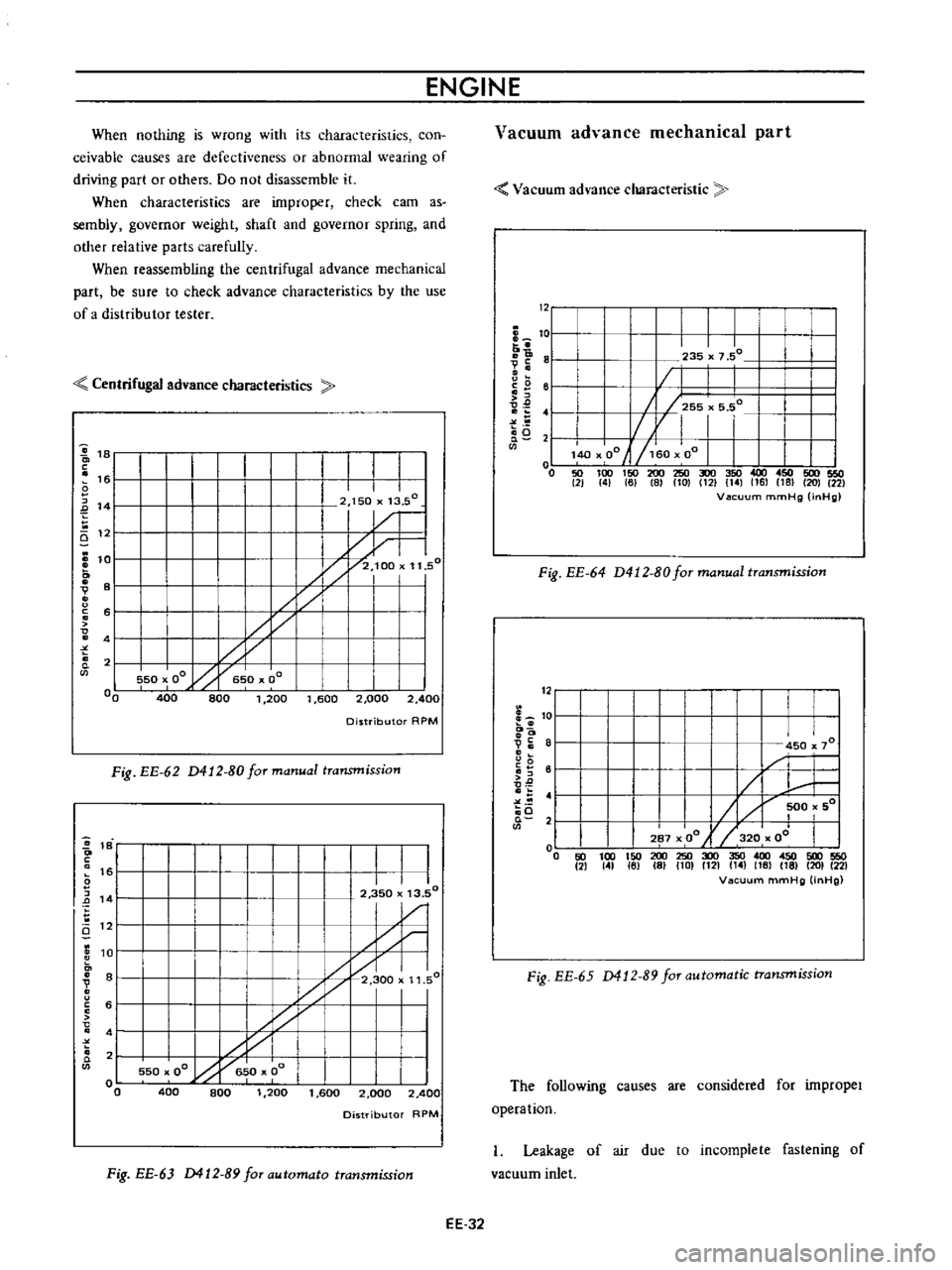
ENGINE
When
nothing
is
wrong
with
its
characteristics
con
ceivable
causes
are
defectiveness
or
abnormal
wearing
of
driving
part
or
others
Do
not
disassemble
it
When
characteristics
are
improper
check
earn
as
sembly
governor
weight
shaft
and
governor
spring
and
other
relative
parts
carefully
When
reassembling
the
centrifugal
advance
mechanical
part
be
sure
to
check
advance
characteristics
by
the
use
of
a
distributor
tester
Centrifugal
advance
characteristics
1
c
1
Ei
12
L
o
V
o
u
c
o
o
t
D
c
s
151
14
e
101
0
81
V
0
u
c
51
0
41
t
0
Q
2
01
0
I
I
I
1
rj
11
50
I
J
2
100
50
oQ
5
00
400
800
1
200
1
600
2
00
Distributor
RPM
Fig
EE
62
D412
80formanual
transmission
I
I
I
2
350
13
50
1
1
1
300
1
1
550
00
h
6
0
0
I
400
800
1
200
1
600
2
000
Distributor
RPM
Fig
EE
63
D412
B9
faT
automata
transmission
2
400
I
11
50
2
400
EE
32
Vacuum
advance
mechanical
part
Vacuum
ad
ance
characteristic
12
I
I
I
I
I
II1
5515
5Q
i
01
40
00
i1j
50
00
1
I
o
50
100
150
200
250
300
350
400
450
500
550
21
41
6
8
101
C121
141
161
181
201
22
V2Icuum
mmHg
inHg
I
I
I
I
7
50
1
1Q
Ii
V
I
o
0
u
i
e
6
tI
2
o
i5
0
235
Fig
EE
64
D412
80
for
manual
transmission
c
1
0
I
o
9i
8
o
u
0
i
61
0
0
0
4
o
Q
2
I
I
I
450
x
70
L
H
1
500
501
287
00
l
320
oJ
I
I
200250300350400450500550
IS
101
1121
t4
16
16
1201
22
Vacuum
mmHg
OnHg
o
50
100
150
2
141
161
Fig
EE
65
0412
89
for
automatic
transmission
The
following
causes
are
considered
for
impropeI
opera
tion
I
Leakage
of
air
due
to
incomplete
fastening
of
vacuum
inlet
Page 453 of 513
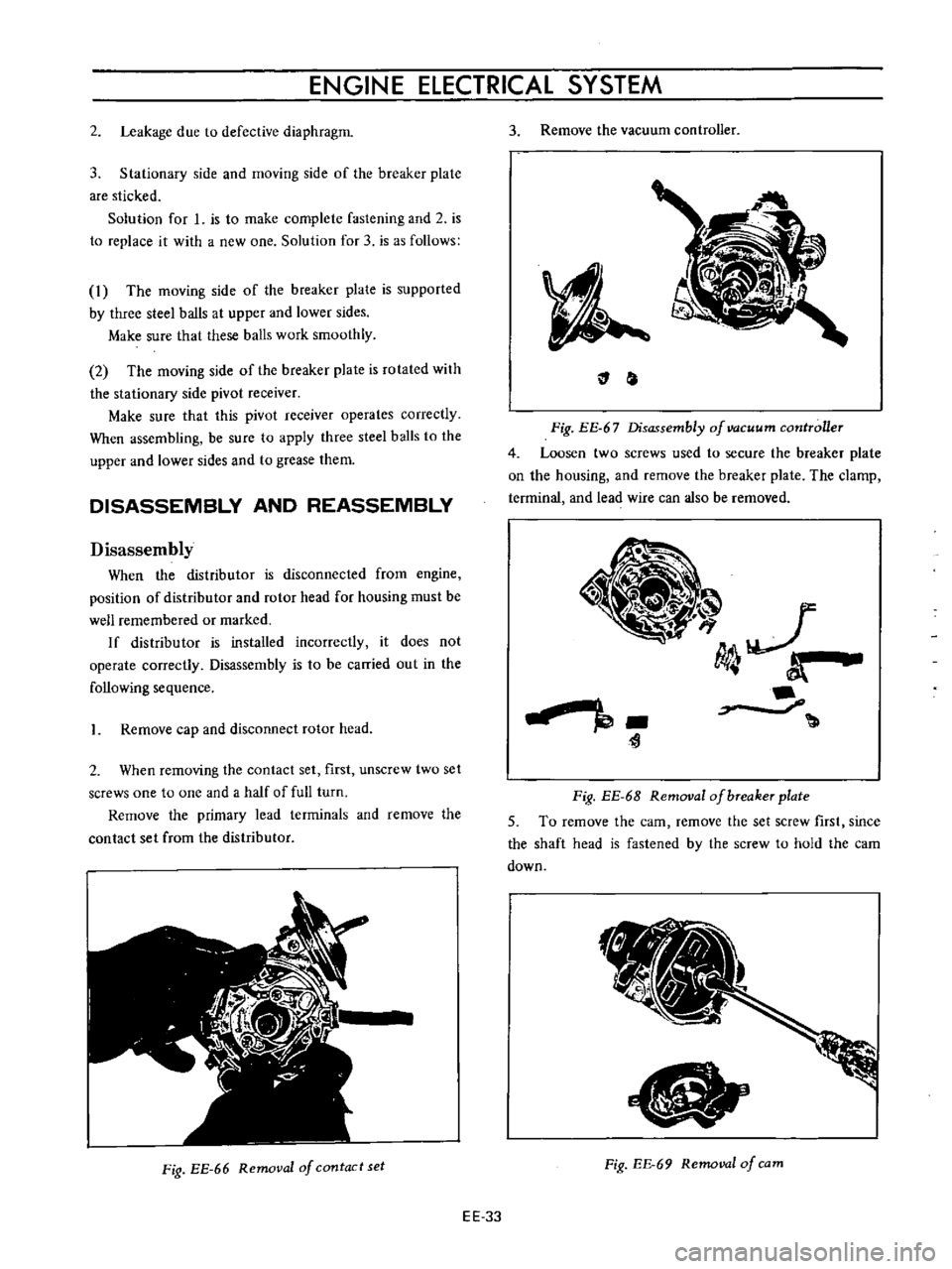
ENGINE
ElECTRICAL
SYSTEM
2
Leakage
due
to
defective
diaphragm
3
Stationary
side
and
moving
side
of
the
breaker
plate
are
sticked
Solution
for
1
is
to
make
complete
fastening
and
2
is
to
replace
it
with
a
new
one
Solution
for
3
is
as
follows
I
The
moving
side
of
the
breaker
plate
is
supported
by
three
steel
balls
at
upper
and
lower
sides
Make
sure
that
these
balls
work
smoothly
2
The
moving
side
of
the
breaker
plate
is
rotated
with
the
stationary
side
pivot
receiver
Make
sure
that
this
pivot
receiver
operates
correctly
When
assembling
be
sure
to
apply
three
steel
balls
to
the
upper
and
lower
sides
and
to
grease
them
DISASSEMBLY
AND
REASSEMBLY
Disassembly
When
the
distributor
is
disconnected
from
engine
position
of
distributor
and
rotor
head
for
housing
must
be
weB
remembered
or
marked
If
distributor
is
installed
incorrectly
it
does
not
operate
correctly
Disassembly
is
to
be
carried
out
in
the
following
sequence
I
Remove
cap
and
disconnect
rotor
head
2
When
removing
the
contact
set
first
unscrew
two
set
screws
one
to
one
and
a
half
of
full
turn
Remove
the
primary
lead
terminals
and
remove
the
contact
set
from
the
distributor
Fig
EE
66
Removal
of
contact
set
EE
33
3
Remove
the
vacuum
controller
Fig
EE
67
Disassembly
of
vacuum
controller
4
Loosen
two
screws
used
to
secure
the
breaker
plate
on
the
housing
and
remove
the
breaker
plate
The
clamp
terminal
and
lead
wire
can
also
be
removed
r
Fig
EE
6B
Removal
ofbTeaker
plate
5
To
remove
the
earn
remove
the
set
screw
first
since
the
shaft
head
is
fastened
by
the
screw
to
hold
the
cam
down
Fig
EE
69
Removal
of
cam
Page 454 of 513
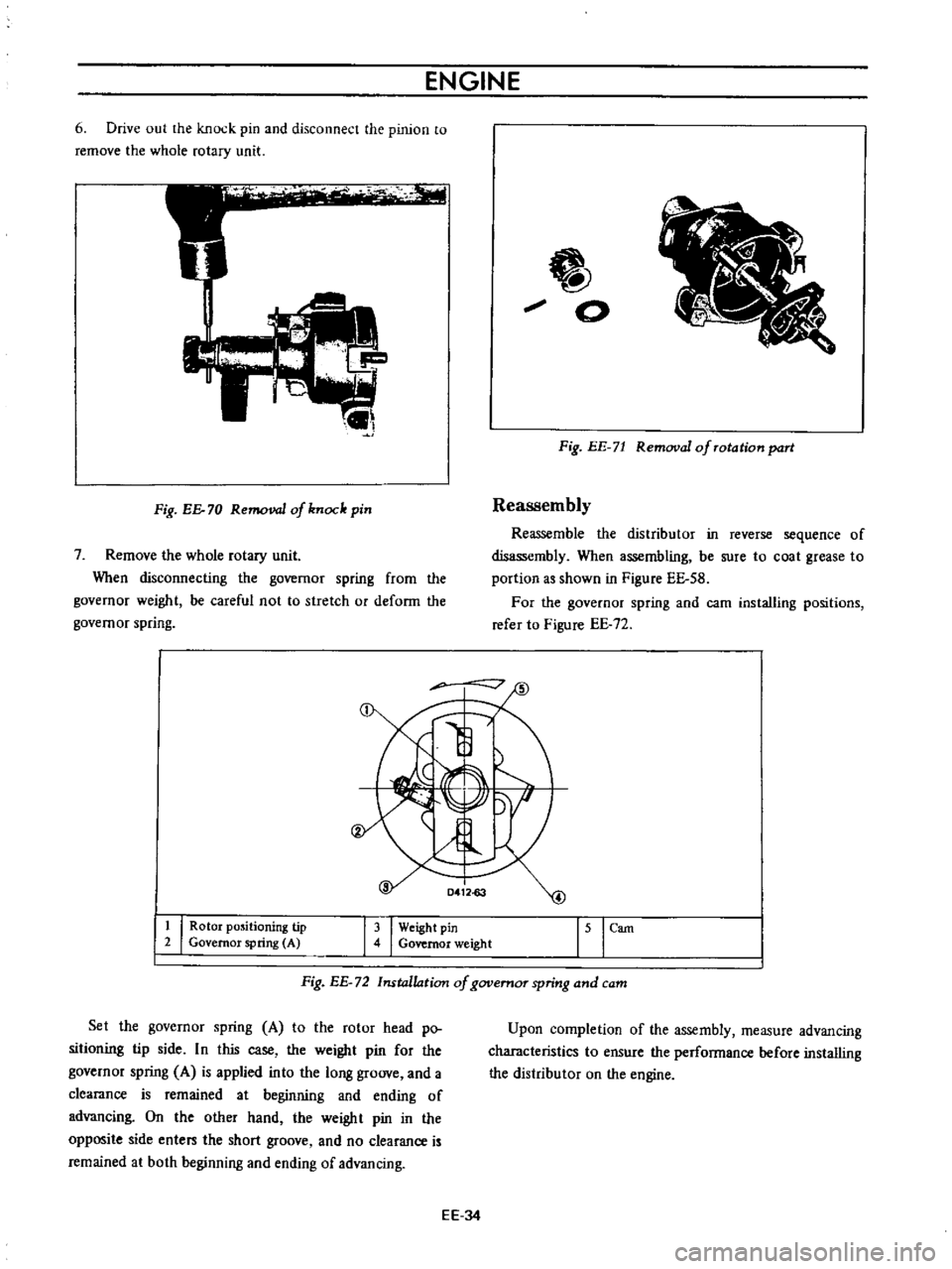
ENGINE
6
Drive
out
the
knock
pin
and
disconnect
the
pinion
to
remove
the
whole
rotary
unit
Fig
EE
70
Removal
of
knock
pin
7
Remove
the
whole
rotary
unit
When
disconnecting
the
governor
spring
from
the
governor
weight
be
careful
not
to
stretch
or
deform
the
governor
spring
tJ
0
Fig
EE
71
Removal
of
Totation
pari
Reassembly
Reassemble
the
distributor
in
reverse
sequence
of
disassembly
When
assembling
be
sure
to
coat
grease
to
portion
as
shown
in
Figure
EE
58
For
the
governor
spring
and
earn
installing
positions
refer
to
Figure
EE
72
1
I
Rotor
positioning
tip
2
Governor
spring
A
13
I
Weight
pin
4
Governor
weight
15
I
earn
Fig
EE
72
Installation
of
governor
spring
and
cam
Set
the
governor
spring
A
to
the
rotor
head
po
sitioning
tip
side
In
this
case
the
weight
pin
for
the
governor
spring
A
is
applied
into
the
long
groove
and
a
clearance
is
remained
at
beginning
and
ending
of
advancing
On
the
other
hand
the
weight
pin
in
the
opposite
side
enters
the
short
groove
and
no
clearance
is
remained
at
both
beginning
and
ending
of
advancing
Upon
completion
of
the
assembly
measure
advancing
characteristics
to
ensure
the
performance
before
installing
the
distributor
on
the
engine
EE
34
Page 455 of 513
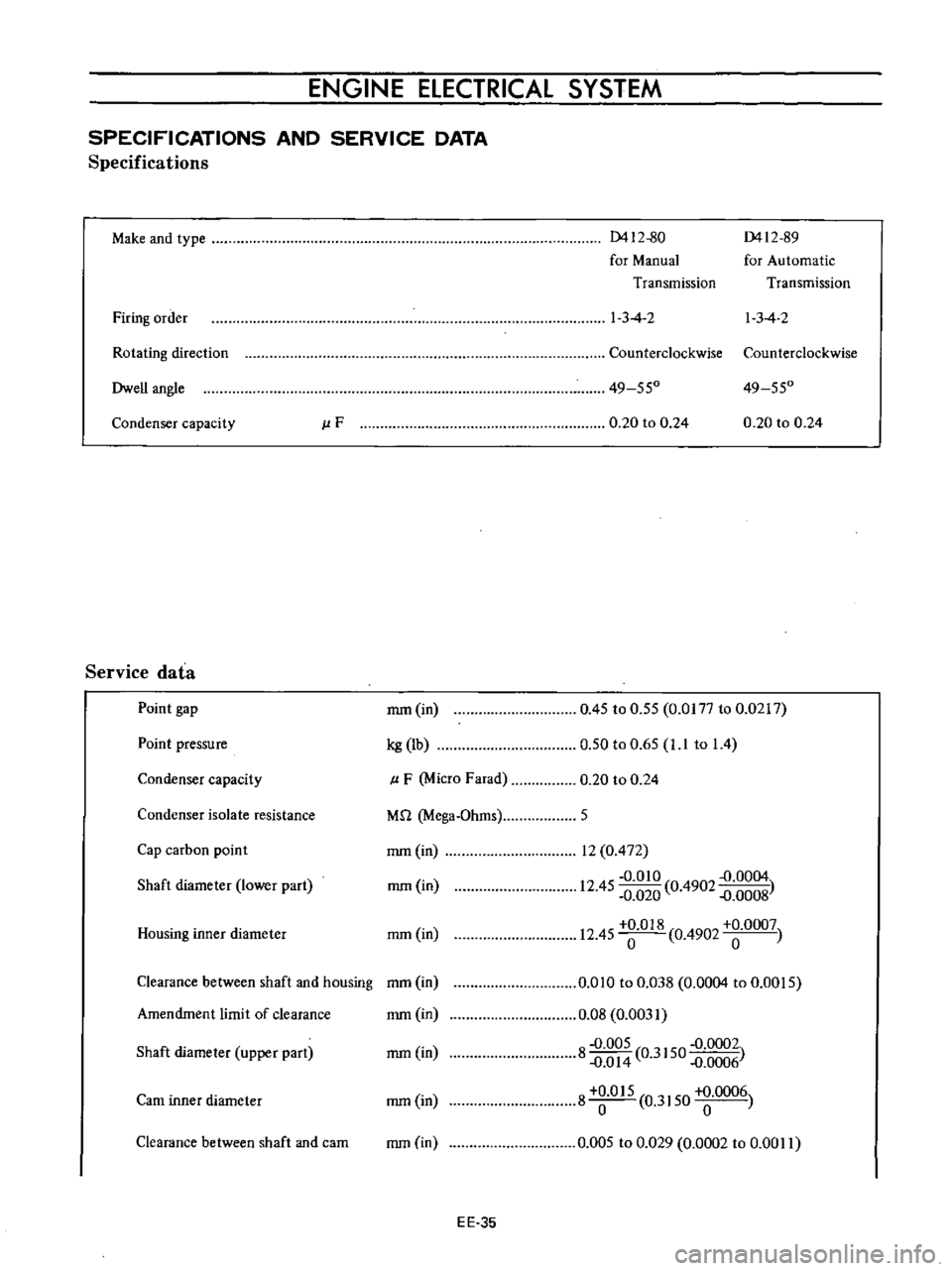
ENGINE
ElECTRICAL
SYSTEM
SPECIFICATIONS
AND
SERVICE
DATA
Specifications
Make
and
type
0412
80
0412
89
for
Manual
for
Automatic
Transmission
Transmission
Firing
order
1
3
4
2
I
3
4
2
Rotating
direction
Counterclockwise
Counterclockwise
Dwell
angle
49
550
49
550
Condenser
capacity
J
lF
0
20
to
0
24
0
20
to
0
24
Service
data
Point
gap
mm
in
0
45
to
0
55
0
0177
to
0
0217
0
50
to
0
65
1
1
to
1
4
Point
pressure
kg
lb
Condenser
capacity
p
F
Micro
Farad
0
20
to
0
24
Condenser
isolate
resistance
M
1
Mega
Ohms
5
Cap
carbon
point
mm
in
rom
in
Housing
inner
diameter
mm
in
12
0
472
0
010
D
0004
12
45
0
020
0
4902
D
0008
12
45
018
0
4902
0007
Shaft
diameter
lower
part
Clearance
between
shaft
and
housing
mm
in
Amendment
limit
of
clearance
mm
in
0
010
to
0
Q38
0
0004
to
0
0015
0
08
0
0031
8
0
005
0
3150
0
0002
D
O
14
D
0006
8
O
15
0
3150
0006
0
005
to
0
029
0
0002
to
0
00
II
Shaft
diameter
upper
part
mm
in
earn
inner
diameter
rom
in
Clearance
between
shaft
and
cam
mm
in
EE
35
Page 456 of 513

ENGINE
Weight
pivot
diameter
mm
in
Weight
hole
diameter
mm
in
Clearance
between
pivot
and
hole
mmOn
5
0
028
0
9
9
1
0011
1
005
1
6
1
0002
5
1
018
0
1969
0
0007
o
0
0
005
to
0
046
0
0002
to
0
0018
IGNITION
COIL
CONTENTS
DESCRIPTION
EE
36
DESCRIPTION
The
Ignition
coil
is
of
an
oil
filled
type
The
ignition
coil
case
is
mted
with
oil
which
has
good
insulating
and
heat
radiating
characteristics
The
ignition
coil
has
a
greater
ratio
between
the
primary
and
secondary
windings
to
step
up
the
battery
voltage
to
the
high
voltage
to
cause
stronger
sparks
to
jump
the
spark
plug
gap
The
cap
is
made
of
alkyd
resin
which
offers
high
resistance
to
electric
arc
and
increased
insulation
The
resistor
in
the
ignition
coil
circuit
helps
produce
strong
sparks
from
starting
to
high
speed
full
power
operation
The
internal
resistor
limits
to
a
maximum
safe
flow
of
the
primary
current
through
the
coil
and
distributor
contact
points
Thus
it
protects
the
contact
points
during
slow
speed
operation
when
they
are
closed
for
long
intervals
The
ignition
coil
and
resistor
should
be
handled
as
a
matched
set
EE
36
SPECIFICATIONS
EE
37
@
@
@l
@
EE143
I
Primary
terminal
2
Secondary
terminal
3
Cap
4
Spring
5
Side
core
6
Primary
coil
7
Secondary
coil
8
insulator
oil
9
Center
core
10
Segment
tt
Case
Fig
EE
73
Construction
Page 457 of 513
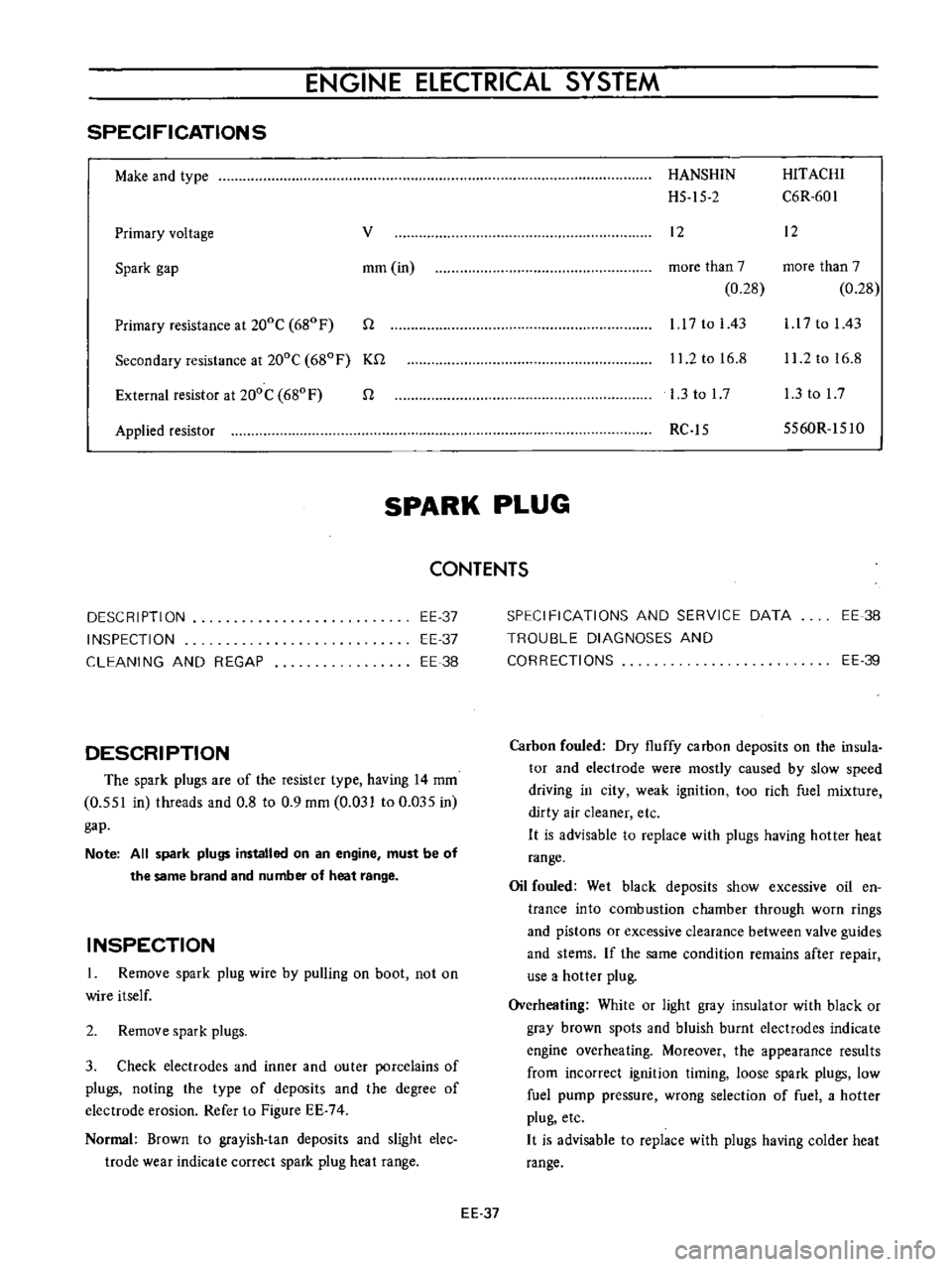
ENGINE
ElECTRICAL
SYSTEM
SPECIFICATIONS
Make
and
type
Primary
voltage
v
Spark
gap
mm
in
Primary
resistance
at
200C
680
F
n
Secondary
resistance
at
200C
680F
Kn
External
resistor
at
200C
680
F
n
Applied
resistor
HANSHIN
HITACHI
H5
15
2
C6R
601
12
12
more
than
7
more
than
7
0
28
0
28
1
17
to
I
43
l
l
7
to
I
43
11
2
to
16
8
11
2
to
16
8
l
3tol7
l
3tol7
RC
15
5560R
151O
SPARK
PLUG
CONTENTS
DESCRIPTION
INSPECTION
CLEANING
AND
REGAP
EE
37
EE
37
EE
38
DESCRIPTION
The
spark
plugs
are
of
the
resister
type
having
14
mm
0
551
in
threads
and
0
8
to
0
9
mm
0
031
to
0
Q35
in
gap
Note
All
spark
plugs
installed
on
an
engine
must
be
of
the
same
brand
and
number
of
heat
range
INSPECTION
1
Remove
spark
plug
wire
by
pulling
on
boot
not
on
wire
itself
2
Remove
spark
plugs
3
Check
electrodes
and
inner
and
outer
porcelains
of
plugs
noting
the
type
of
deposits
and
the
degree
of
electrode
erosion
Refer
to
Figure
EE
74
Normal
Brown
to
grayish
tan
deposits
and
slight
elec
trode
wear
indicate
correct
spark
plug
heat
range
SPECIFICATIONS
AND
SERVICE
DATA
TROUBLE
DIAGNOSES
AND
CORRECTIONS
EE
38
EE
39
Carbon
fouled
Dry
fluffy
carbon
deposits
on
the
insula
tor
and
electrode
were
mostly
caused
by
slow
speed
driving
in
city
weak
ignition
too
rich
fuel
mixture
dirty
air
cleaner
etc
H
is
advisable
to
replace
with
plugs
having
hotter
heat
range
Oil
fouled
Wet
black
deposits
show
excessive
oil
en
trance
into
combustion
chamber
through
worn
rings
and
pistons
or
excessive
clearance
between
valve
guides
and
stems
If
the
same
condition
remains
after
repair
use
a
hotter
plug
Overheating
White
or
light
gray
insulator
with
black
or
gray
brown
spots
and
bluish
burnt
electrodes
indicate
engine
overheating
Moreover
the
appearance
results
from
incorrect
ignition
timing
loose
spark
plugs
low
fuel
pump
pressure
wrong
selection
of
fuel
a
hotter
plug
etc
H
is
advisable
to
replace
with
plugs
having
colder
heat
range
EE
37
Page 458 of 513
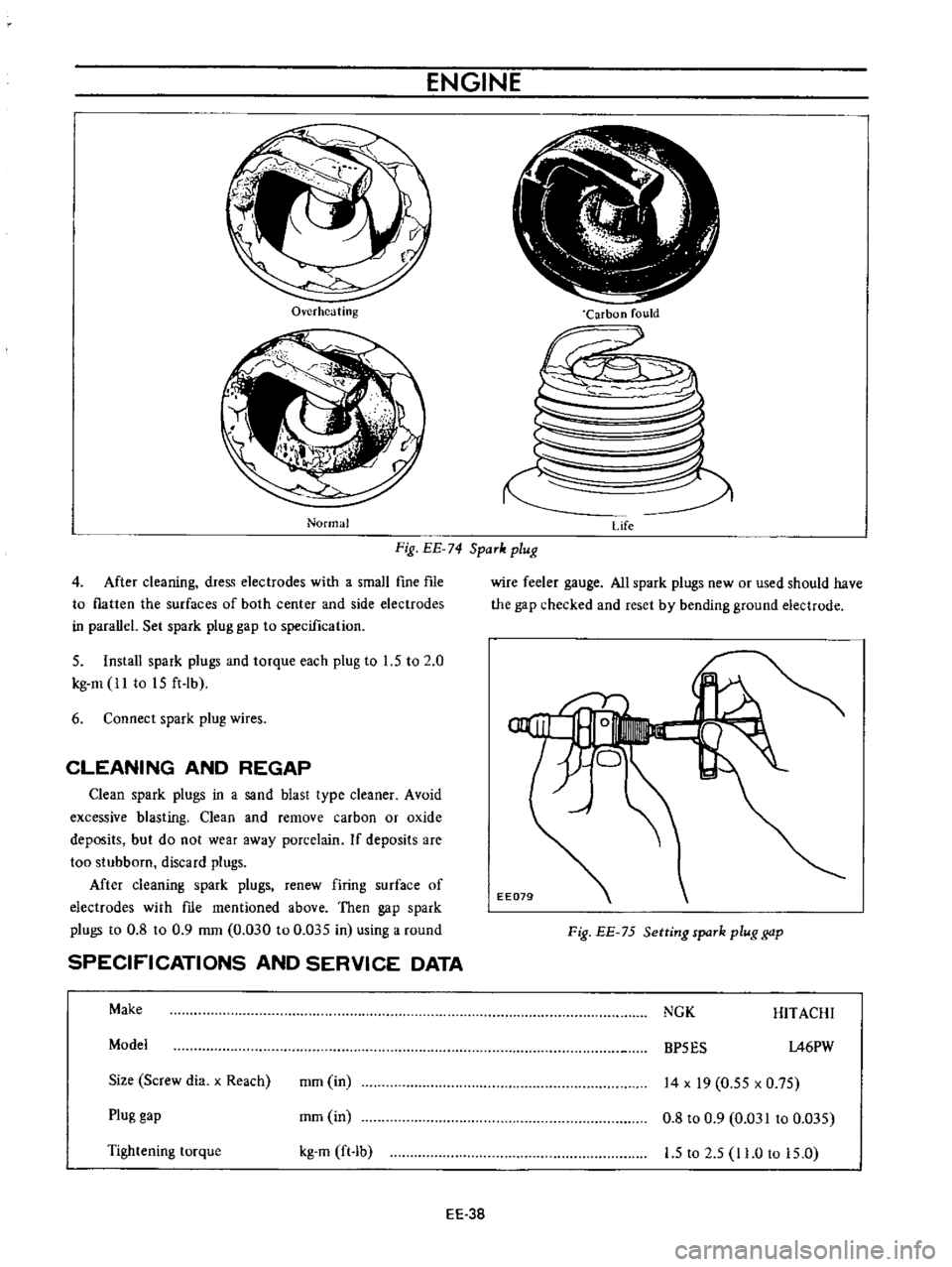
ENGINE
Overheating
Normal
Carbon
fould
Fig
EE
74
SpaTk
plug
Life
4
After
cleaning
dress
electrodes
with
a
small
fine
fIle
to
flatten
the
surfaces
of
both
center
and
side
electrodes
in
parallel
Set
spark
plug
gap
to
specification
5
Install
spark
plugs
and
torque
each
plug
to
1
5
to
2
0
kg
m
ll
to
15
ft
lb
6
Connect
spark
plug
wires
CLEANING
AND
REGAP
Clean
spark
plugs
in
a
sand
blast
type
cleaner
Avoid
excessive
blasting
Clean
and
remove
carbon
or
oxide
deposits
but
do
not
wear
away
porcelain
If
deposits
are
too
stubborn
discard
plugs
Mter
cleaning
spark
plugs
renew
firing
surface
of
electrodes
with
me
mentioned
above
Then
gap
spark
plugs
to
0
8
to
0
9
mm
0
030
to
0
035
in
using
a
round
SPECIFICATIONS
AND
SERVICE
DATA
Make
Model
Size
Screw
dia
x
Reach
mm
in
Plug
gap
mm
in
Tightening
torque
kg
m
ft
b
EE
38
wire
feeler
gauge
All
spark
plugs
new
or
used
should
have
the
gap
checked
and
reset
by
bending
ground
electrode
Fig
EE
75
Setting
spaTk
plug
gap
NGK
HITACHI
BP5ES
1A6PW
14
x
19
0
55
x
0
75
0
8
to
0
9
0
031
to
0
035
1
5
to
2
5
11
0
to
15
0
Page 459 of 513
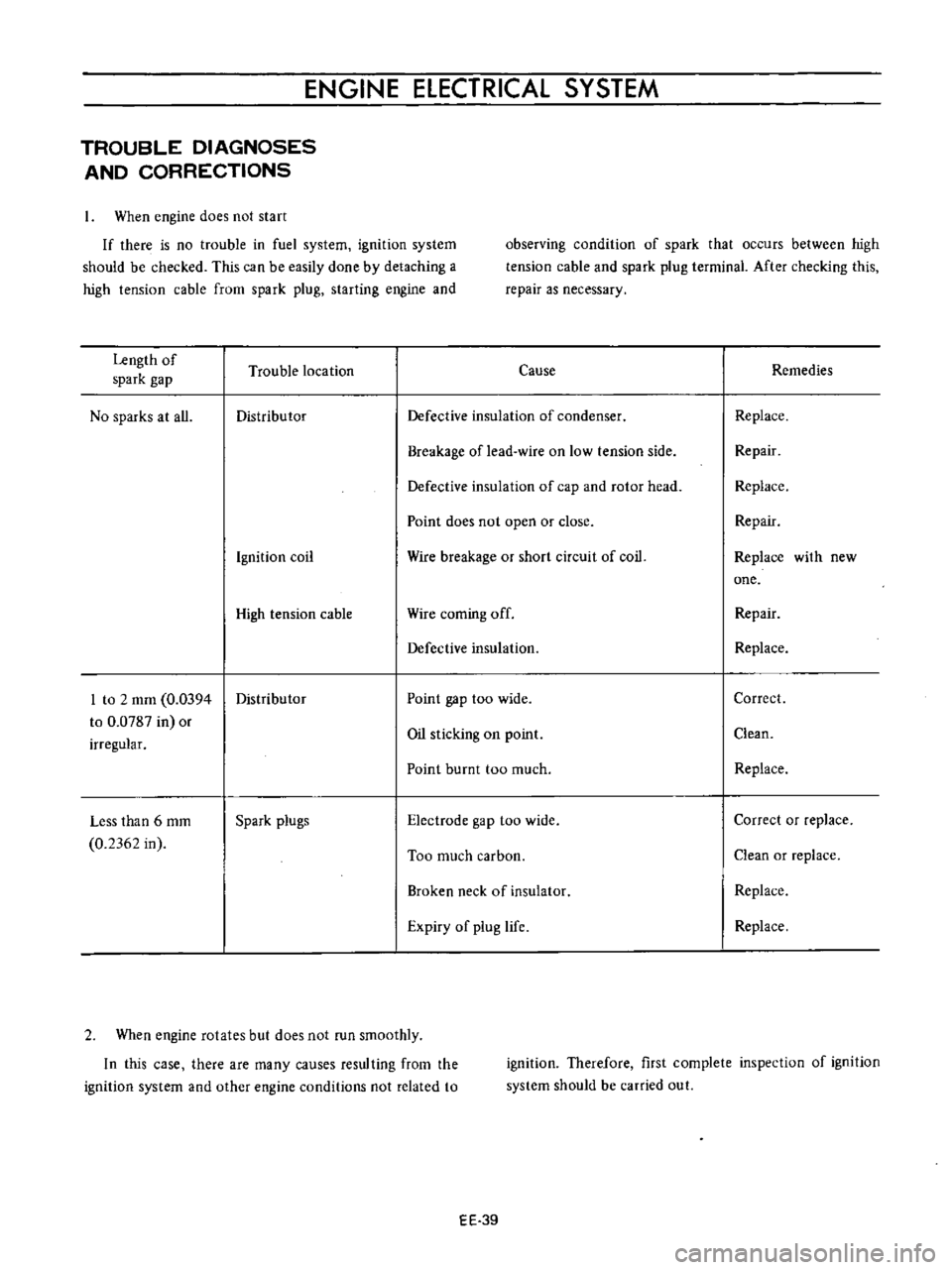
ENGINE
ELECTRICAL
SYSTEM
TROUBLE
DIAGNOSES
AND
CORRECTIONS
When
engine
does
not
start
If
there
is
no
trouble
in
fuel
system
ignition
system
should
be
checked
This
can
be
easily
done
by
detaching
a
high
tension
cable
from
spark
plug
starting
engine
and
observing
condition
of
spark
that
occurs
between
high
tension
cable
and
spark
plug
terminal
After
checking
this
repair
as
necessary
Length
of
Trouble
location
Cause
Remedies
spark
gap
No
sparks
at
all
Distributor
Defective
insulation
of
condenser
Replace
Breakage
of
lead
wire
on
low
tension
side
Repair
Defective
insulation
of
cap
and
rotor
head
Replace
Point
does
not
open
or
close
Repair
Ignition
coil
Wire
breakage
or
short
circuit
of
coil
Replace
with
new
one
High
tension
cable
Wire
coming
off
Repair
Defective
insulation
Replace
I
to
2
mm
0
0394
Distributor
Point
gap
too
wide
Correct
to
0
0787
in
or
Oil
sticking
on
point
Clean
irregular
Point
burnt
too
much
Replace
Less
than
6
mm
Spark
plugs
Electrode
gap
too
wide
Correct
or
replace
0
2362
in
Too
much
carbon
Clean
or
replace
Broken
neck
of
insulator
Replace
Expiry
of
plug
life
Replace
2
When
engine
rotates
but
does
not
run
smoothly
In
this
case
there
are
many
causes
resulting
from
the
ignition
system
and
other
engine
conditions
not
related
to
ignition
Therefore
first
complete
inspection
of
ignition
system
should
be
carried
out
EE
39
Page 460 of 513

Troubles
Engine
misses
Engine
causes
knocking
very
often
Engine
does
not
give
enough
power
Trouble
location
Distributor
Ignition
coil
High
tension
code
Spark
plugs
Distributor
Spark
plugs
Distributor
Spark
plugs
ENGINE
Causes
Dirty
point
Improper
point
gap
Leak
of
electricity
of
cap
and
rotor
head
Defective
insulation
of
condenser
Defective
arm
Defective
spring
of
arm
Breakage
oflead
wire
Worn
out
or
shaky
breaker
plate
Worn
out
or
shaky
distributor
shaft
Layer
short
circuit
or
use
of
inferior
quality
Deterioration
of
insulation
and
leak
of
electricity
Dirty
Leak
of
electricity
at
upper
porcelain
insu
lator
Improper
and
advance
timing
Coming
off
or
breakage
of
governor
spring
A
pin
or
a
hole
of
governor
portion
worn
out
Burnt
too
much
Improper
and
retarded
timing
Defedive
function
of
governor
Dirty
point
Point
gap
too
narrow
Dirty
EE
40
Remedies
Clean
Correct
Repair
or
replace
Replace
Oil
shaft
Replace
assembly
Replace
Replace
assembly
Replace
assembly
Replace
with
good
one
Replace
Clean
Repair
or
replace
Correct
the
fitting
Correct
or
replace
Replace
Replace
Correct
the
fitting
Replace
assembly
Clean
Correct
Clean